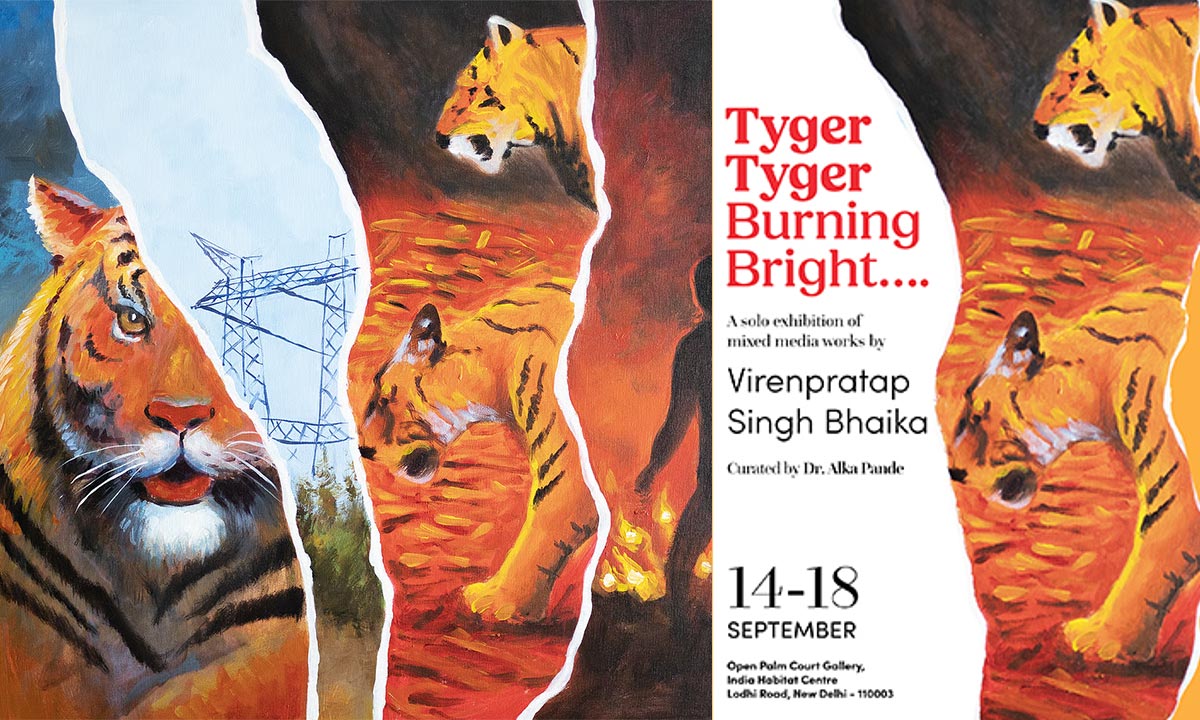
Tyger Tyger Burning Bright, a show of an up-and-coming artist, Virenpratap Singh Bhaika, is a great conversation between nature and men, between myth and facts, between devastation and promise. This exhibition, curated by the renowned art historian Dr. Alka Pande, will be open between 13 and 18 September 2025, and it will invite people to rethink our ways of living in the natural world.
Exhibition Details
| Event | Information |
|---|---|
| Exhibition Name | Tyger Tyger Burning Bright |
| Artist | Virenpratap Singh Bhaika |
| Curator | Dr. Alka Pande |
| Dates | 13 – 18 September 2025 |
| Timings | 11:00 AM – 7:00 PM |
| Venue | Open Palm Court Gallery, India Habitat Centre, Lodhi Road, New Delhi |
| Entry | Free |
Message form the Show
The most memorable thing about this show is its multi-sensory nature. Bhaika displays 15 bold paintings, his own sketchbooks, and a 30-minute film named Roar and Resilience. The paintings are full of colour and allegory showing tigers walk through the burning woods, metallic excavators stand like predators of the world, and broken landscapes and the boundaries between human development and the fragile balance of nature.
The movie, in the meantime, gives a sense of urgency and emotional preview of the strength of wild species and the vulnerability of their living ecosystem. The first time his sketchbooks are presented gives something personal, in the form of pencil studies, sketches, and notes of forests and conservation camps. They expose the invisible work behind the completed works and base his passion on experience.
Art Rooted in the Wild
The art of Bhaika is influenced by immersion instead of distant depiction of wildlife, unlike the work of the artists. He is now studying Fine Art at the Harrow School in the UK, and he has also done conservation work in Tadoba, Namibia and other Indian national parks. He has also been influenced by Central Indian tribal artists of Gond whose complex, nature-based visual language has had an in-depth impact on his style.
The authenticity of his works is unique due to this grounding. He does not merely paint tigers as embodiments of beauty, but he paints them as intelligent creatures at war, as the representatives of ecologies being brought to the edge. There are those that replicate Gond traditions in their designs and down-to-earth tonalities, and there are those that incorporate some elements of the Western classical and modernist art to produce sharp contrasts. He even works with renowned Gond artist Japani Shyam daughter of the legendary Jangarh Singh Shyam to further establish a link between tradition and the modern.
Preservation of Nature and Art
The main contradiction of Tyger Tyger Burning Bright is in the images that the beauty of nature versus the ruthless development of the human race. Tigers are shown with cranes, excavators, and burning industrial figures, which imply the process of deforestation, climate change, and destruction of their habitats that now threaten their existence.
However, these images are not only warnings. There is also a strand of perseverance in them. The title of Bhaika is based on a famous poem of William Blake, which implies fear. His works are not just images over what is being lost; they are also a symbol of what remains and what can be preserved as soon as we can. The movie Roar and Resilience reflects this as nature struggles to survive even during the times of destruction.
This is the exhibition that puts the problem in the context of emotions again, when environmental crises are too often diminished to a numerical form. Bhaika makes us remember that conservation is a science or a policy but it is also about empathy, wonder, and responsibility.
Conclusion
Tyger Tyger Burning Bright is not just an exhibition but it is a call to arms. Bhaika challenges us to realize that we will survive with the wild as long as its survival is considered. You walk out of the gallery as a lover of art, but also learning that the wild voices that are rapidly dying.







